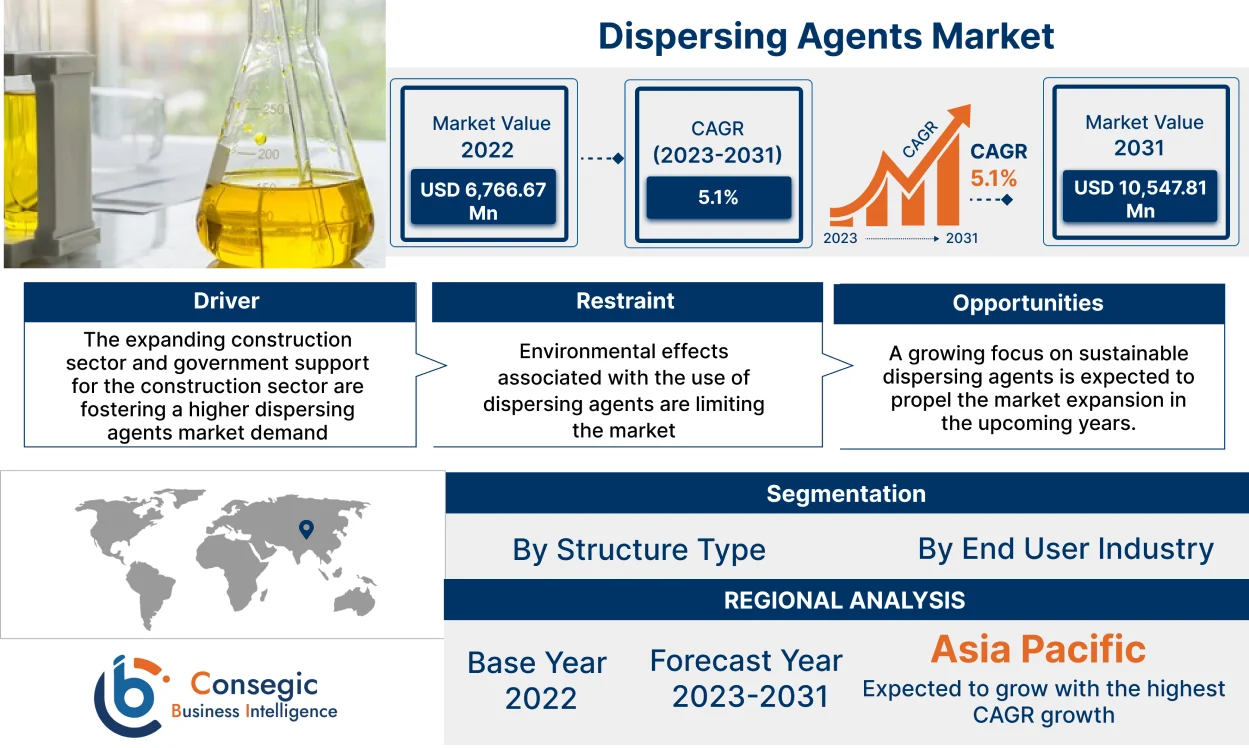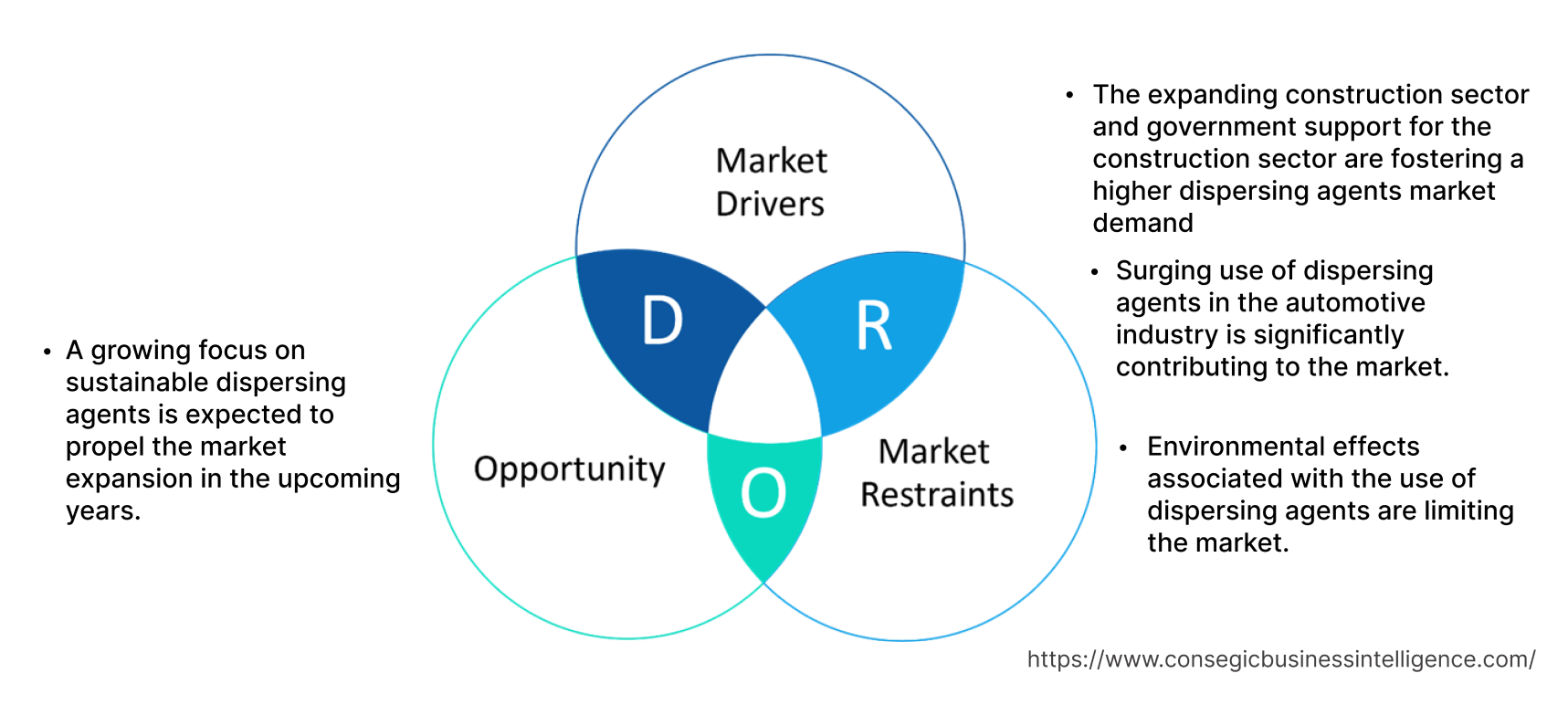- Summary
- Table Of Content
- Methodology
Dispersing Agents Market Size :
Consegic Business Intelligence analyzes that the dispersing agents market size is growing with a CAGR of 5.1% during the forecast period (2023-2031). The market accounted for USD 6,766.67 million in 2022 and USD 7,079.97 million in 2023, and the market is projected to be valued at USD 10,547.81 Million by 2031.
Global Dispersing Agents Market Scope & Overview:
A dispersing agent is a chemical compound that helps to stabilize the suspension or emulsion solution by improving the separation of solid and liquid and preventing particles from clumping together. They come in various forms including polymers, surfactants, and complexing agents. These agents are widely used to improve the stability of the solution, enhance the performance of the solution by increasing the effectiveness of the pigments in paints, and improve the consistency of pharmaceutical formulations. Additionally, these agents reduce the viscosity of the suspension solution, making the solution easier to handle.
Based on the analysis, these agents are utilized in various industries such as paints and coatings, pharmaceuticals, food processing, and construction among others. Moreover, the advancements in the formulations of these agents and increasing demand for high-quality products are the factors propelling the trends of the market.
Global Dispersing Agents Market Insights :
Key Drivers :
The expanding construction sector and government support for the construction sector are fostering a higher dispersing agents market demand
The agents such as plasticizers, and water reducers are the primary agents used in the preparation of various raw materials used in the construction procedure including concrete mixtures, mortars, grouts, and cementitious coatings. The expanding construction sector is one of the prominent reasons fuelling the requirement for these agents which is driving the expansion of the market across the globe. Rising urbanization and infrastructure development are fueling the need for concrete which uses these agents.
Based on the analysis, these agents make sure that the cement particles and other materials are evenly distributed, improving the strength, and adhesion of the material and improving its resistance to cracking the cement. Thus, such agents are an important component in construction materials.
Additionally, the escalating construction sector is significantly contributing to the market trends.
For instance,
- According to the data provided by India Brand Equity Foundation, the Dubai government and India signed a contract in October 2021 to build infrastructure in Jammu and Kashmir, including industrial parks, IT towers, multipurpose towers, logistics centers, medical colleges, and specialized hospitals.
Consequently, government support for the construction sector and the rising construction sector is driving the dispersing agents market trends.
For instance,
- According to the data provided by the National Bureau of Statistics, in February 2023, the value-added output of the construction sector in China accounted for USD 1172.92 billion in 2022, which increased by 5.5 % over 2021.
Moreover, government support in the construction sector is creating a significant gain in the requirement for dispersing agents market.
Surging use of dispersing agents in the automotive industry is significantly contributing to the market.
Dispersing agents play a crucial role in the automotive sector, contributing to various aspects of vehicle performance, functionality, and aesthetics. The range of these agents that serve pivotal aspects in this sector for adhesives and sealants, coatings and paints, lubricants and greases, and polymers among others. These chemicals provide certain characteristic advantages such as hydrophobicity, flexibility, increased strength and durability, protection against corrosion and scratches, and reduced friction and wear, among others further enhancing the overall performance and efficiency of the automotive parts and vehicles.
Additionally, based on the analysis in fuel and engine additives, these agents prevent deposit formation and optimize the performance and emission of the engine. Owing to this, commendable efforts are being made by the leading players to expand their portfolio.
For instance,
- In May 2022, LANXESS, a leading dispersing agent manufacturer, and Advent, announced a joint acquisition of a materials business from DSM for a purchase price of around USD 4.02 billion. Under this agreement, LANXESS is contributing its High-Performance Materials (HPM) business unit to the joint venture. HPM is one of the leading suppliers of high-performance polymers, which are used primarily in the automotive sector. This joint venture and acquisition is expanding the automobile high-performance polymer portfolio of LANXESS.
Moreover, based on the analysis, these factors lead to the use of these agents in the automotive sector which is driving the automotive market which includes electric vehicles, and passenger cars.
For instance,
- According to the data provided by the Germany Trade and Invest in September 2022, German passenger car and light commercial vehicle OEM generated foreign market revenue of almost USD 274 billion in 2021, a 10 % increase over 2020. Thus, the use of these agents in the automotive sector is propelling the expansion of the market.
Overall, the critical role played by these agents in the automotive applications is augmenting the market.
Key Restraints :
Environmental effects associated with the use of dispersing agents are limiting the market.
The significant environmental impact associated with the use of these agents is the potential factor restraining the market. Traditional dispersing agents normally contain chemicals such as ethylene glycol, alkylphenol ethoxylates, phosphates, and ethylenediaminetetraacetic acid among others that possess adverse effects on the environment. These chemicals generally lead to toxicity to aquatic organisms and bioaccumulation. These substances seep into the water and soil, causing contamination and upsetting natural ecosystems. Furthermore, based on the analysis, the production process for some dispersing compounds releases harmful emissions or byproducts, which worsens the negative effect on the environment. Thus, the negative effect of these agents on the environment are the factors hindering the dispersing agents market growth.
Future Opportunities :
A growing focus on sustainable dispersing agents is expected to propel the market expansion in the upcoming years
The demand for advanced and eco-friendly solutions in the chemical sector has led to an increase in the demand for sustainable dispersing agents. The demand for these agents with improved sustainability profiles is rising because of the increase in awareness about environmental issues and various regulations designed to lessen the environmental impact of these substances. As these agents, including polymers, surfactants, and complexing agents are widely used in various industries, it has become essential to adopt a sustainable approach towards them. As per the analysis, sustainable dispersing agents offer superior alternatives to traditional agents. This is because they possess environment-friendly attributes and regulatory compliance benefits.
These chemicals are typically derived from renewable sources like biomass and agricultural waste, which reduces dependence on fossil fuels and lowers carbon emissions. They also exhibit characteristics like low toxicity, reduced carbon footprint, renewable sourcing, and biodegradability. Many chemical solutions with sustainable properties that are not harmful to the environment have been introduced.
For instance,
- Dow is launching EcoSense™ 2470 surfactant in September 2023, which is a sustainable solution that harnesses innovative carbon capture technology for the home care market, providing customers with an eco-friendly option to meet their formulation goals.
- Additionally, in November 2023, Clariant announced the showcasing new portfolio of wetting and these agents for water-based formulations dedicated to industrial coating applications in containers, transportation, and construction. Ceridust 8170 M is an addition to the growing portfolio of PTFE-free (polytetrafluoroethylene) additives. On display, it offers safer, more sustainable options for paints and coatings.
Thus, the growing focus on these is driving the market in the forecast year.
Dispersing Agents Market Report Insights :
| Report Attributes | Report Details |
| Study Timeline | 2017-2031 |
| Market Size in 2031 (USD Million) | USD 10,547.81 Million |
| CAGR (2023-2031) | 5.1% |
| By Structure Type | Anionic, Cationic, Non-ionic, Hydrophilic, Hydrophobic, and Others. |
| By End User Industry | Construction, Paints and Coatings, Detergent, Agricultural, Pharmaceuticals, Pulp and Paper, Oil and Gas Sector, Automotive, and Other |
| By Region | North America, Europe, Asia Pacific, Latin America, and Middle East & Africa |
| Key Players | BASF SE, CLARIANT, Arkema, Nouryon, Solvay, Evonik, Dow, Ashland, LG Chem, CHRYSO UK, Allnex GMBH, and LANXESS |
| Geographies Covered | |
| North America | U.S. Canada Mexico |
| Europe | U.K. Germany France Spain Italy Russia Benelux Rest of Europe |
| APAC | China South Korea Japan India Australia ASEAN Rest of Asia-Pacific |
| Middle East and Africa | GCC Turkey South Africa Rest of MEA |
| LATAM | Brazil Argentina Chile Rest of LATAM |
| Report Coverage | Revenue Forecast, Competitive Landscape, Growth Factors, Restraint or Challenges, Opportunities, Environment & Regulatory Landscape, PESTLE Analysis, PORTER Analysis, Key Technology Landscape, Value Chain Analysis, Cost Analysis, and Regional Trends & Forecast |
Dispersing Agents Market Segmental Analysis :
By Structure Type :
The structure type is categorized into anionic, cationic, non-ionic, hydrophilic, hydrophobic, and others. In 2022, the anionic segment accounted for the highest dispersing agents market share of 35.77% in the dispersing agents market. Anionic dispersing agents are negatively charged compounds that generally contain a hydrophilic group. These agents are widely used in various industries including paints, coatings, adhesives, textiles, and ceramics to uniformly disperse solid particles present in the solution. In the paints and coating industries, anionic dispersing agents play a crucial role in dispersing pigments, fillers, and additives ensuring a homogeneous distribution and stable formulations. These agents help prevent the accumulation of particles and enhance the performance of the coating. Various new products are being introduced containing these agents for painting and coating solutions.
For instance,
- In June 2020, Clariant launched a range of pigment dispersions solution that helps North American industrial coatings manufacturers with tinting reformulation.
Moreover, the non-ionic segment is expected to hold the highest CAGR over the forecast period. Non-ionic surfactants are substances that do not carry net charge in their hydrophilic head group such as polyethylene glycol and polypropylene glycol. They offer effective dispersing capabilities while maintaining stability and compatibility with other formulations. These agents are widely used in various industries including adhesives, pharmaceuticals, and personal care and cosmetics among others. Thus, the utilization of the non-ionic segment is expected to propel the growth of the segment in the coming years.
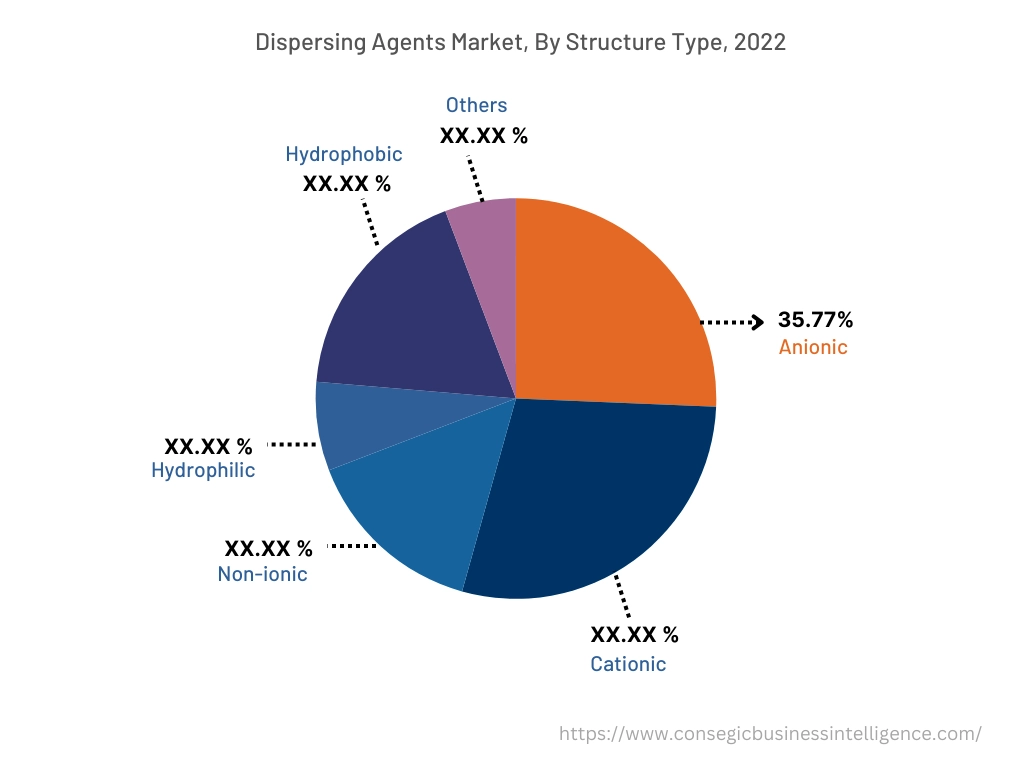
By End User Industry :
The end-user industry segment is categorized into construction, paints and coatings, detergent, agricultural, pharmaceuticals, pulp and paper, oil and gas, automotive, and others. In 2022, the paints and coatings accounted for the highest market share in the overall dispersing agents market. These agents are substances that are used as essential additives in paints and coatings and ensure uniform dispersion of pigments and additives in the formulations. These agents keep paints stable and homogeneous, enhancing their looks and functionality by dissolving clustered compounds and preventing the settling of the paints. They strengthen properties such as paint adhesion, durability, and resistance to environmental variables while promoting consistent color, and preventing sedimentations. These agents also aid in reducing the viscosity of the paint, which makes the application simpler and results in a smooth finish. New products and additives are being launched to enhance the properties of paints and coatings.
For instance,
- In July 2022, Evonik launched its dispersing additive called TEGO Dispers 658. The latest TEGO dispersing agent improves the sustainability of the pigment, and coatings, and simultaneously offers a high-performance profile.
Thus, the use of these agents in paints and coatings is driving the growth of the segment.
Moreover, the pharmaceutical is expected to hold the fastest CAGR over the forecast period. These agents are experiencing rapid growth in the pharmaceutical sector because they play a vital role in formulating stable suspensions, emulsions, and nanoparticle-based drug delivery systems. These agents generally ensure uniform distribution of active pharmaceutical ingredients (API's) within the formulations enhancing the availability and efficacy of the formulation. These substances prevent the formation of clusters and ensure the formation of the medication in proper dosing. Additionally, these agents are utilized for the production of nano-scaled drug particles, improving the dissolving and solubility rate of poorly soluble medications, which is crucial for enhancing drug delivery, and therapeutic outcomes. Thus, the demand for advanced drug delivery systems, and novel pharmaceutical formulations is expected to create lucrative dispersing agents market opportunities for the segment growth and trends.
By Region :
The regional segment includes North America, Europe, Asia Pacific, the Middle East and Africa, and Latin America.
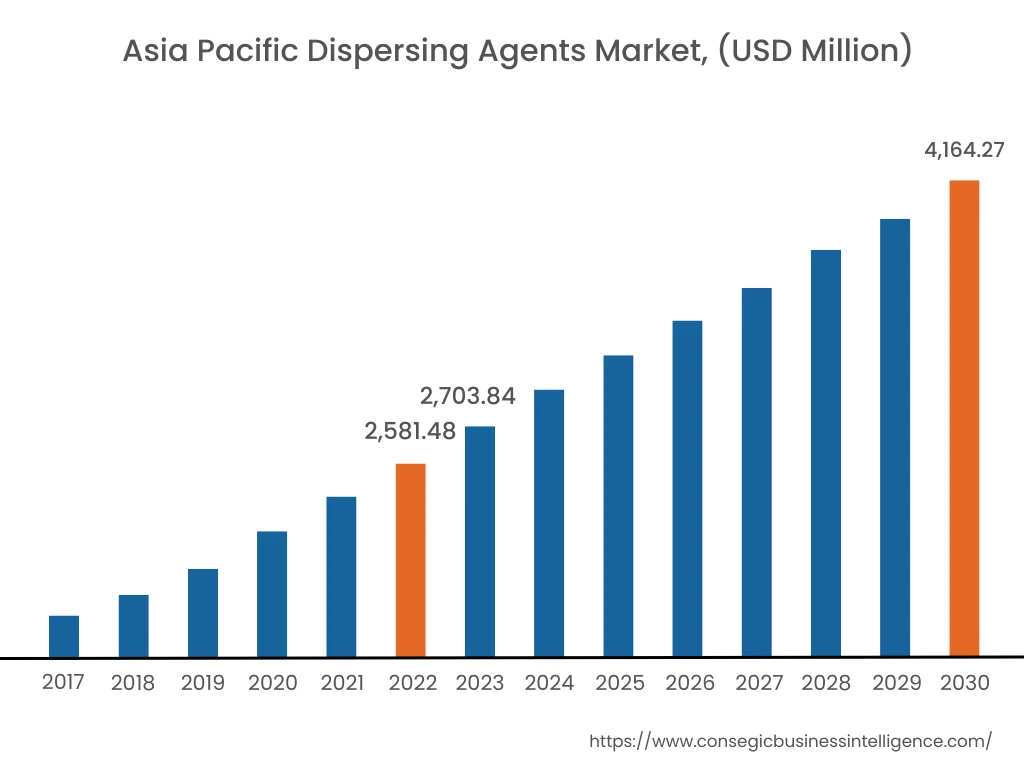
In 2022, Asia Pacific accounted for the highest market share at 38.15% valued at USD 2,581.48 Million in 2022 and USD 2,703.84 Million in 2023, it is expected to reach USD 4,164.27 Million in 2031 and it is also anticipated to hold the fastest CAGR over the forecast period. In Asia Pacific, China accounted for a major market share of 22.68% in the year 2022. The significant growth of the dispersing agents market across the Asia Pacific region is attributed to factors such as rising urbanization, and growing population leading to the requirement for advanced infrastructure. Based on the analysis, these factors are leading to higher trends for these agents from industries such as paints and coatings, detergents, and automotive among others.
Additionally, the investment by the governments of countries in this region for infrastructure development is expected to contribute to market growth.
For instance,
- According to the data provided by the India Brand Equity Foundation in August 2023, in Budget 2023-24, capital investment outlay for infrastructure is being increased by 33% to USD 122 billion, which would be 3.3 percent of GDP. Additionally, India plans to spend USD 1.4 trillion on infrastructure through the National Infrastructure Pipeline' in the next five years.
As per the dispersing agents market analysis, all these above-mentioned factors are collectively driving the dispersion agents market demand and trends in the Asia Pacific region and creating lucrative growth opportunities for the dispersion agents market trends in the Asia Pacific region.
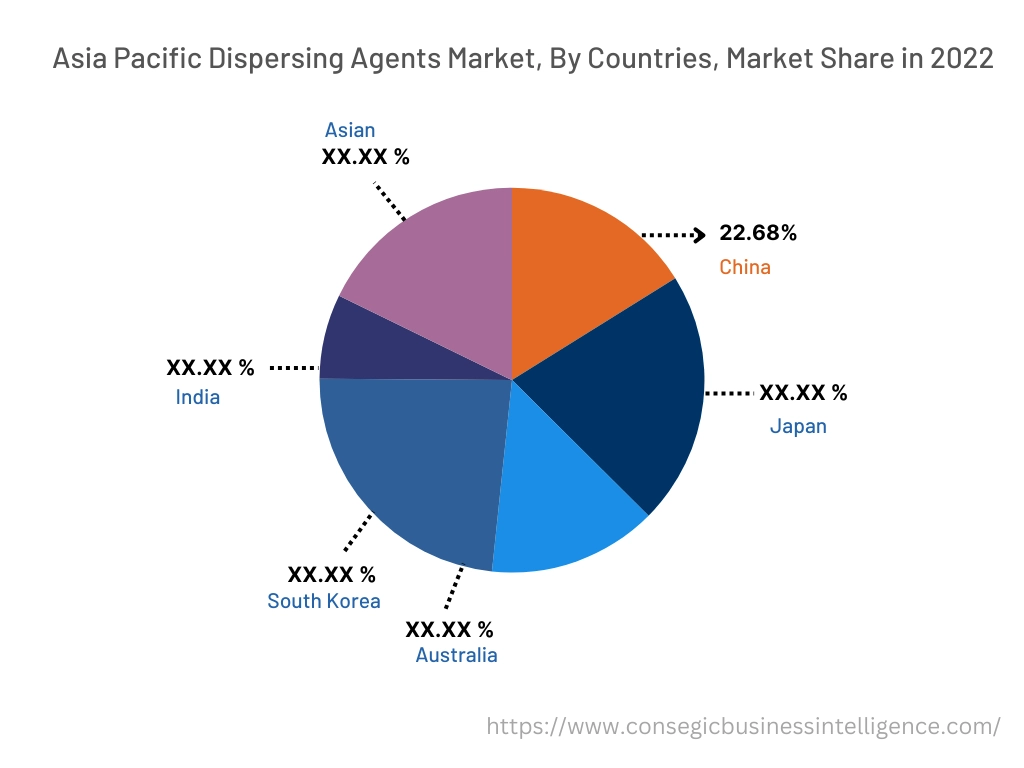
Top Key Players & Market Share Insights :
The global dispersing agents industry is highly competitive, with several large players and numerous small and medium-sized enterprises. These companies have strong research and development capabilities and a strong presence in the market through their extensive product portfolios and distribution networks. The market is characterized by intense competition, with companies focusing on expanding their product offerings and increasing their market share through mergers, acquisitions, and partnerships. The key players in the market include-
Recent Industry Developments :
- In July 2022, Evonik announced the launch of dispersing additive called TEGO Dispers 658. The latest TEGO dispersing agent improves the sustainability of the pigment, and coatings, and simultaneously offers a high performance profile.
- In June 2022, Clariant, a leading global provider of dispersing agents, announced the launch of new universal polymeric dispersing agent for high-quality pigment preparations that can incorporate organic and inorganic pigments.
Key Questions Answered in the Report
What was the market size of the dispersing agents market in 2022? +
In 2022, the market size of dispersing agents was USD 6,766.67 million.
What will be the potential market valuation for the Dispersing Agents industry by 2031? +
In 2031, the market size of Dispersing Agents will be expected to reach USD 10,547.81 million.
What are the key factors driving the growth of the dispersing agents market? +
The expanding construction sector and government support for the construction sector are fostering a higher demand for dispersing agents
What is the dominant segment in the dispersing agents market for the product type? +
In 2022, the anionic segment accounted for the highest market share of 35.77% in the overall dispersing agents market.
Based on current market trends and future predictions, which geographical region is the dominating region in the Dispersing Agents market? +
Asia Pacific accounted for the highest market share in the overall market.
